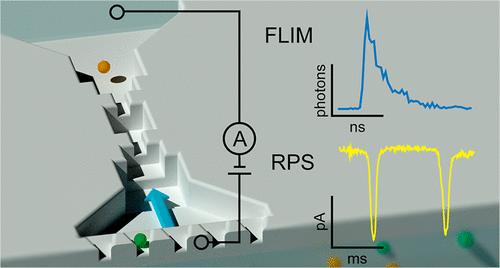Resistive-Pulse Sensing Coupled with Fluorescence Lifetime Imaging Microscopy for Differentiation of Individual Liposomes
IF 16
1区 材料科学
Q1 CHEMISTRY, MULTIDISCIPLINARY
引用次数: 0
Abstract
Characterization of individual biological nanoparticles can be significantly improved by coupling complementary analytical methods. Here, we combine resistive-pulse sensing (RPS) with fluorescence lifetime imaging microscopy (FLIM) to differentiate liposomes at the single-particle level. RPS measures the particle volume, shape, and surface-charge density, and FLIM determines the fluorescence lifetime of the fluorophore associated with the lipid membrane. The RPS devices are fabricated in-plane on a glass substrate to facilitate coupling of RPS with FLIM measurements. For proof-of-concept, we studied liposomes containing various cholesterol concentrations with membrane-intercalated Di-8-ANEPPS, whose fluorescence lifetime is known to be sensitive to cholesterol concentrations in the membrane. RPS-FLIM revealed that increasing cholesterol concentrations in the liposome from 0% to 50% increased the fluorescence lifetimes from 2.1 ± 0.2 to 3.4 ± 0.5 ns, respectively. Moreover, RPS-FLIM discerned liposome populations with the same cholesterol concentration but labeled with dyes that have different fluorescence lifetimes (Di-8-ANEPPS and COE-S6), parsing two particle populations with statistically identical volumes, cholesterol concentration, and lipid composition. Interrogation with RPS-FLIM occurred with individual particles making a single pass through the detection region and overcomes issues with fluorescence spectral overlap that limits traditional methods. We envision RPS-FLIM as a versatile and scalable technique with the potential to differentiate biological particles at the single-particle level to simultaneously inform on particle size, surface-charge density, membrane composition, and identity.

电阻脉冲传感耦合荧光寿命成像显微镜用于单个脂质体的分化
通过耦合互补分析方法,可以显著改善单个生物纳米颗粒的表征。在这里,我们结合了电阻脉冲传感(RPS)和荧光寿命成像显微镜(FLIM)来区分单颗粒水平的脂质体。RPS测量颗粒体积、形状和表面电荷密度,FLIM测定与脂质膜相关的荧光团的荧光寿命。RPS器件在玻璃基板上平面内制造,以促进RPS与FLIM测量的耦合。为了验证概念,我们用膜插层的Di-8-ANEPPS研究了含有不同胆固醇浓度的脂质体,其荧光寿命已知对膜中的胆固醇浓度敏感。RPS-FLIM显示,将脂质体中胆固醇浓度从0%增加到50%,荧光寿命分别从2.1±0.2 ns增加到3.4±0.5 ns。此外,RPS-FLIM识别了具有相同胆固醇浓度的脂质体群体,但用具有不同荧光寿命的染料(Di-8-ANEPPS和COE-S6)标记,分析了具有统计学上相同体积,胆固醇浓度和脂质组成的两个颗粒群体。RPS-FLIM的探测发生在单个粒子通过检测区域时,克服了荧光光谱重叠的问题,这限制了传统方法。我们设想RPS-FLIM是一种通用的、可扩展的技术,具有在单颗粒水平上区分生物颗粒的潜力,同时可以了解颗粒大小、表面电荷密度、膜组成和身份。
本文章由计算机程序翻译,如有差异,请以英文原文为准。
求助全文
约1分钟内获得全文
求助全文
来源期刊

ACS Nano
工程技术-材料科学:综合
CiteScore
26.00
自引率
4.10%
发文量
1627
审稿时长
1.7 months
期刊介绍:
ACS Nano, published monthly, serves as an international forum for comprehensive articles on nanoscience and nanotechnology research at the intersections of chemistry, biology, materials science, physics, and engineering. The journal fosters communication among scientists in these communities, facilitating collaboration, new research opportunities, and advancements through discoveries. ACS Nano covers synthesis, assembly, characterization, theory, and simulation of nanostructures, nanobiotechnology, nanofabrication, methods and tools for nanoscience and nanotechnology, and self- and directed-assembly. Alongside original research articles, it offers thorough reviews, perspectives on cutting-edge research, and discussions envisioning the future of nanoscience and nanotechnology.
 求助内容:
求助内容: 应助结果提醒方式:
应助结果提醒方式:


